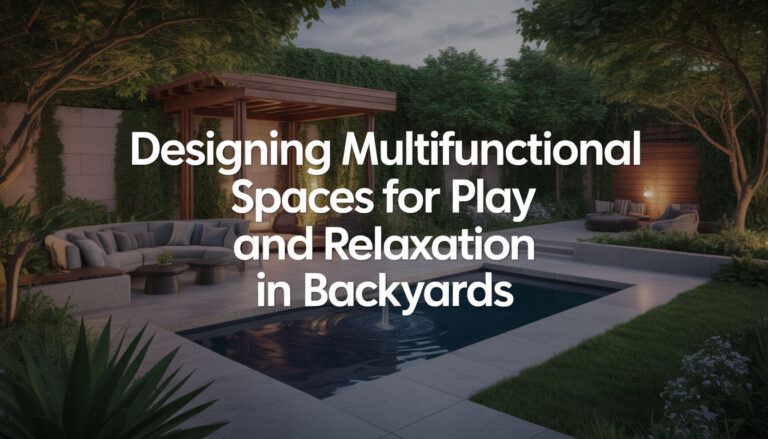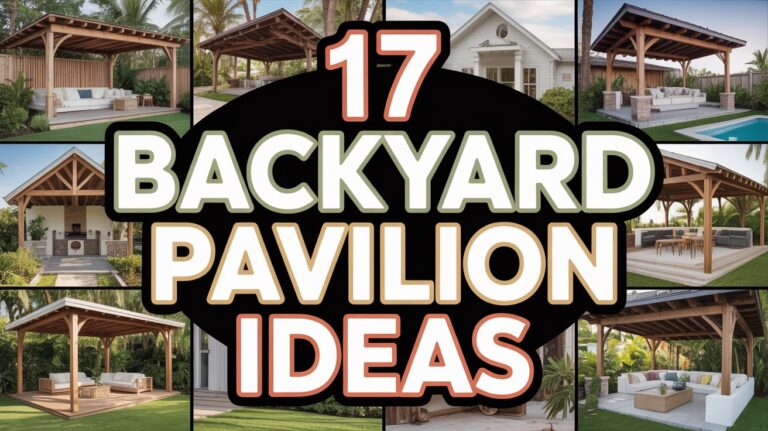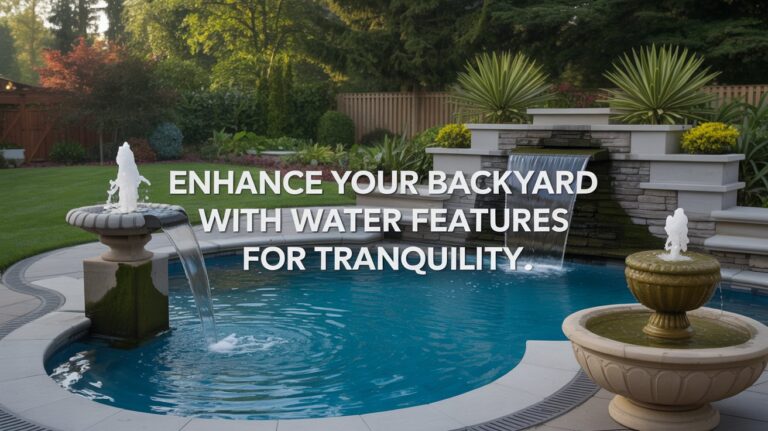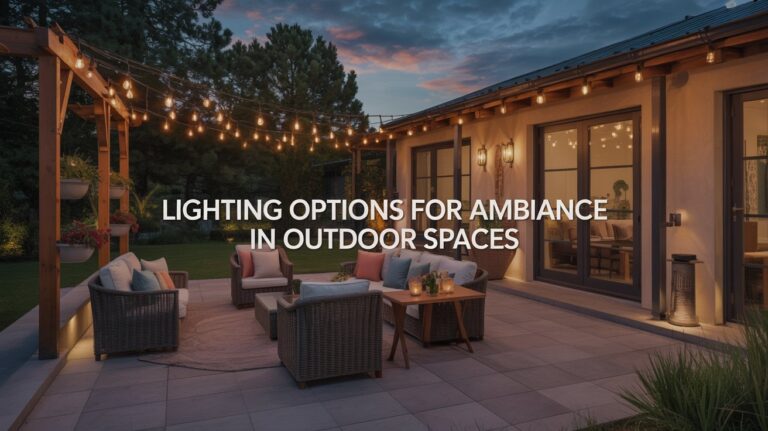The Role of Landscaping in Creating a Cohesive Backyard Retreat
I have been, or can be if you click on a link and make a purchase, compensated via a cash payment, gift, or something else of value for writing this post. As an Amazon Associate, I earn from qualifying purchases. Please read my full Affiliate Disclosure for more information.
A cohesive backyard retreat starts with a unified design language that ties color, materials, and structure into a clear flow. You define zones with thoughtful plantings and durable hardscape, then select materials that age together for visual unity. Proportion and scale guide rhythm, while framing views and focal points create intentional vistas. Lighting extends usability into evening, and seasonal interest keeps appeal year-round. If you keep exploring, you’ll uncover how all these elements align seamlessly.
Key Takeaways
- Establish a unified color palette that ties plants, hardscape, furniture, and textiles together for a cohesive mood.
- Select durable, cohesive materials and textures that age uniformly and reduce visual noise.
- Define zones with plant layering and hardscape anchors to create clear, navigable spaces.
- Use sightlines, focal points, and proportion to create balance and guiding rhythms.
- Choose easy-care, resilient plantings and low-maintenance features to sustain long-term harmony.
Designing a Unified Color Palette
A unified color palette anchors your backyard retreat by tying plants, hardscape, furniture, and textiles into a cohesive whole. You’ll approach color with method, aligning hue, saturation, and value to support function and mood. Start with a restrained base; introduce accents through focal plantings and textiles, ensuring contrast enhances legibility. Color coordination hinges on consistent undertones across materials, avoiding clashing cools and warms. Palette selection should reflect site light and architectural context, preserving legibility from key viewpoints. Document swatches and test under different times of day. This disciplined process yields a durable, harmonious outdoor environment you can maintain confidently.
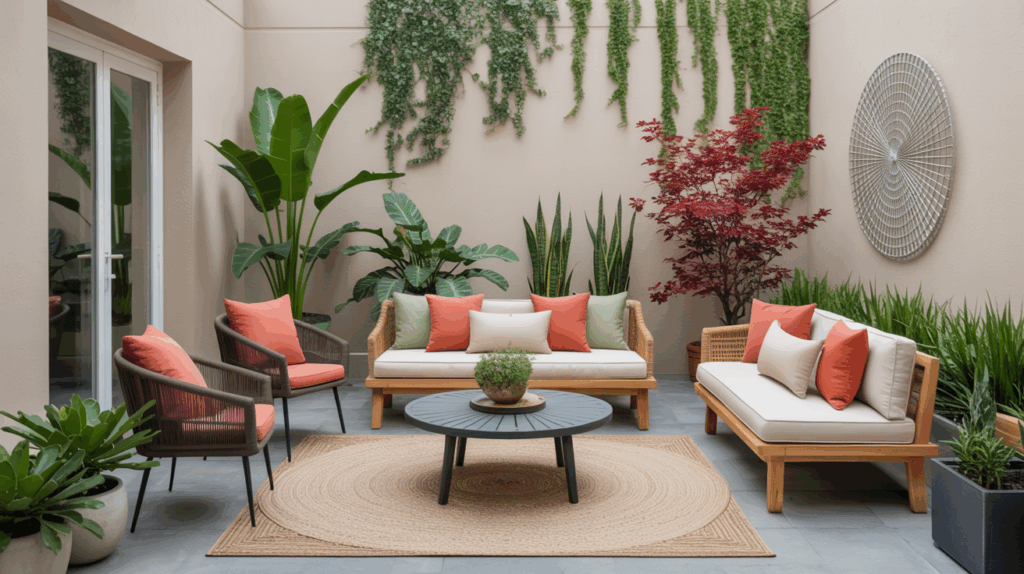
Defining Zones Through Plantings and Hardscape
Defining zones through plantings and hardscape starts with translating your unified palette into spatial cues. You map use areas by scale, texture, and form, aligning paths, seating, and focal points with planting layers. Use plant layering to create subtle progressions between zones, combining groundcovers, mid-story shrubs, and canopy trees to control sightlines and microclimates. Hardscape elements—paths, walls, seating—anchor these progressions, establishing clear yet fluid boundaries. Consider privacy screens where enclosure matters, selecting evergreen or dense deciduous options to maintain year-round delineation. This approach yields cohesive zones that feel deliberate, navigable, and adaptable to changes in light, activity, and season.
Selecting Materials for Cohesion and Durability
Material harmony guides your selection to guarantee transitions feel intentional across surfaces and elements. Pair durable materials that share compatible textures and scales, so the design remains cohesive under daily use. Prioritize long-lasting combos, balancing resilience with visual unity, to support a retreat that ages well.
Material Harmony
Selecting materials that harmonize in tone, texture, and performance is essential for a cohesive backyard retreat; when chosen thoughtfully, surface pairings, colors, and durability work together to create a unified outdoor space. You’ll prioritize material palettes that repeat key attributes across surfaces, reducing visual noise while enhancing tactile consistency. Consider how garden sculptures and outdoor furniture anchor focal points, guiding circulation and rhythm without overstating dominance. Choose durable, low-maintenance options with compatible joinery and finishes to minimize maintenance. Align permeable vs. hardscape ratios for drainage and usability. Subtle contrasts should refine rather than disrupt the overarching material narrative.
Durable Pairings
Durable pairings hinge on balancing performance with aesthetic continuity, ensuring that surface treatments, textures, and colors withstand use while reading as a single design language. You evaluate material communities by cohesion and resilience, pairing finishes that resist weather, wear, and staining with complementary forms. Garden furniture, pavers, and planters should share a common palette and tactile language to minimize visual clutter while maximizing longevity. Consider water features as anchors for material logic, selecting stone, metal, and composite surfaces that age uniformly. Test joinery, slip resistance, and maintenance needs; document guidelines to sustain harmony across outdoor rooms, year after year.
Proportions and Scale: Creating Balance
Proportions and scale establish visual harmony by guiding how elements relate to each other and to the space as a whole. You’ll balance plant mass, materials, and furnishings to avoid dominance or underuse, ensuring cohesiveness. Scale balance comes from aligning object sizes with viewing distances and the landscape’s dimensions, creating a comfortable rhythm. Proportion harmony emerges when plantings echo hardscape dimensions, and textures repeat at predictable intervals. Consider focal points that anchor the scene without overpowering adjacent elements. Precision in measurement and placement yields clarity, legibility, and function, empowering you to craft a cohesive retreat with disciplined, intentional relationships.
Framing Views With Structure and Focal Points
Framing views with structure and focal points centers on guiding the eye through deliberate alignments and deliberate pauses. You align sightlines with architectural or landscape elements to create intentional pauses, directing attention to key moments. Implement focal point placement at strategic intervals, using specimen trees, sculpture, or water features to anchor you as you move along pathways. View framing relies on contrast, scale, and rhythm, ensuring each vista feels purposeful rather than accidental. Maintain clean sightlines, avoid clutter, and adjust plantings as seasons shift. When executed coherently, the composition yields a cohesive retreat where attention rests on meaningful, well-placed elements.
The Sensory Language: Texture, Scent, and Sound
How do texture, scent, and sound shape a backyard retreat? You evaluate tactile surfaces, selecting plant textures, hardscape treatments, and furniture that invite touch and contrast. Textural variety guides movement, defining zones without heavy framing; smooth versus rough surfaces influence pace and comfort. Scent is mapped to bloom windows and seasonality, using aromatic plants to reinforce wayfinding and memory without overpowering nearby spaces. Sound is layered through wind, water, and vegetation, creating a controllable acoustic environment that supports relaxation and focus. Integrate garden art and wildlife habitat to deepen sensory coherence and ecological value.
Lighting That Extends the Day and Enhances Flow
Lighting that extends the day and enhances flow uses layered sources, calibrated to support circulation, safety, and mood without overpowering the landscape. You should align luminance with principal paths and gathering zones, avoiding glare. Employ subtle edges for depth, with warm color temperature to complement plant textures. Solar placement matters: place fixtures where sun exposure optimizes recharge and minimizes clutter. Pathway illumination should be continuous, guiding movement without harsh punctuations. Integrate from trees, ground-level uplights, and step lights to stabilize rhythm. Guarantee controls are intuitive, and dimming options preserve nighttime ecology while maintaining accessibility and design cohesion.
Seasonal Interest and Year-Round Appeal
Seasonal interest and year-round appeal hinge on a deliberate plant palette, texture variety, and structural elements that adapt to shifting light, temperature, and viewing angles. You design with strategic layering: seasonal blooms for focal points, evergreen textures for continuity, and seasonal foliage shifts to maintain visual weight. Consider adaptable materials—pergolas, screens, and specimen trees—that frame views across the year. Use a cohesive palette with contrasting leaf shapes to maintain clarity from all angles. Maintain redundancy in form and function so color and texture reappear in different seasons, ensuring a balanced, legible retreat even as conditions change.
Maintenance Feet: Easy Care, Long-Term Beauty
When you choose easy-care plants, you simplify maintenance while preserving visual impact and seasonal structure. This section highlights an Easy-Care Plants Guide and practical Long-Term Beauty Tips to sustain color, form, and resilience with minimal intervention. You’ll see how design choices—drought tolerance, soil compatibility, and clean maintenance routines—translate into enduring landscape performance.
Easy-Care Plants Guide
Consider easy-care plants that combine resilience with long-term beauty, selecting species that thrive with minimal intervention and steady performance. You’ll prioritize native species to align with regional conditions, reducing water needs and maintenance while supporting wildlife habitat. Choose drought-tolerant perennials and evergreen shrubs that provide year-round structure, then layer with grasses for movement and groundcovers to suppress weeds. Design focuses on spatial rhythm, with grouping by bloom times and foliage color to sustain visual interest. Favor soil-friendly, low-fertilizer options and simple pruning regimes. This guide supports cohesive, low-input landscapes that endure through seasons without constant attention.
Long-Term Beauty Tips
After selecting easy-care plantings, you’ll want long-term beauty that persists with minimal intervention. You maintain cohesion by selecting durable textures and year-round structure, ensuring a unified palette across borders and focal points. Prioritize slow-growing, pest-resilient species, and schedule lightweight pruning to sustain form without compromising health. Integrate garden furniture and water features as architectural anchors, aligning materials and color to the plantings’ cadence. Use layered planting to reduce maintenance, with mulch that moderates moisture and weeds. Plan seasonal tweaks that require minimal labor, reinforcing rhythm, scale, and harmony while supporting efficient irrigation and soil health.
Integrating Hardscape With Softscape for Harmony
Integrating hardscape and softscape creates a cohesive outdoor room by aligning materials, textures, and scale from paths to planting. You’ll balance form and function, ensuring progressions feel natural rather than abrupt. Consider material continuity, scale, and maintenance needs when choosing elements like pavers, walls, and groundcovers. This harmony supports purposeful circulation and microclimates, enhancing usability.
- Pathway design: select durable, slip-resistant surfaces that echo nearby hard features and guide traffic without interrupting planting.
- Connection points: Create intermediate spaces with seating or focal plants to unify zones.
- Water features: integrate quiet, low-maintenance systems that reflect light and soften edges without overpowering vegetation or views.
Conclusion
You’ve established a cohesive backyard retreat by aligning color, texture, and form across softscape and hardscape. Keep zoning clear with plantings and pathways, reinforcing flow through consistent materials and scale. Frame every vista with purposeful structure and focal points, while lighting extends usability and highlights balance. Prioritize seasonal interest for year-round appeal, and design for easy maintenance with durable, modular elements. When in doubt, revisit the palette and proportions to preserve harmony as the landscape matures.



